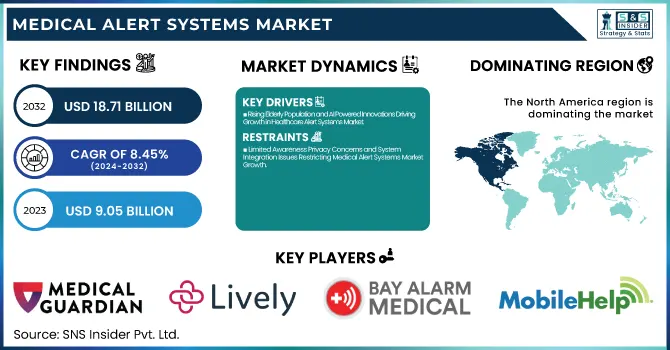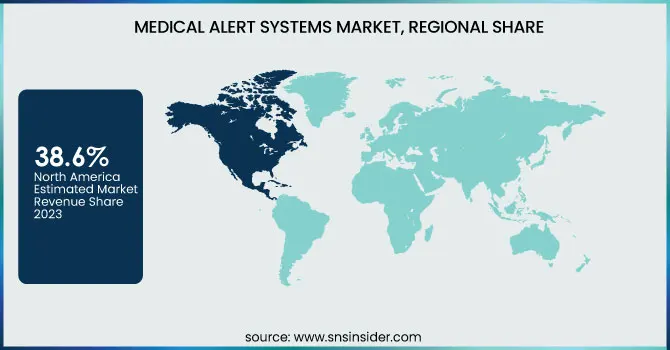Medical Alert Systems Market Size & Trends:
The Medical Alert Systems Market Size was valued at USD 9.05 billion in 2023 and is expected to reach USD 18.71 billion by 2032, growing at a CAGR of 8.45% over the forecast period 2024-2032. Innovations in product performance, AI integration, and service quality push the growth of the medical alert systems market with improved emergency response and user experience. The devices are reviewed based on response time, false alarm rates, and battery life to ensure dependability.

To Get more information on Medical Alert Systems Market - Request Free Sample Report
Predictive fall detection and health trend monitoring powered by AI enable proactive care. Where the quality of service is determined by device resilience, uptime for connectivity, and firmware updates as it should be operating in the first place. Moreover, these systems are designed to support users with chronic pathological features such as heart disease and functional disabilities such as the inability to move, thus maximizing the accuracy of the alerts and minimizing the risk of hospitalization, as they are an Integral technology for remote patient monitoring.
Medical Alert Systems Market Dynamics
Key Drivers:
-
Rising Elderly Population and AI Powered Innovations Driving Growth in Healthcare Alert Systems Market
The increasing geriatric population and rising prevalence of chronic diseases are one of the major factors escalating the growth of the market for healthcare alert systems. The growing demographic of independent elderly citizens led to a rising demand for affordable alternative emergency solutions. Moreover, technological breakthroughs in the field of mobile personal emergency response systems (PERS) with GPS facility and artificial intelligence (AI) based monitoring solutions have further improved the mobility of these systems boosting their appeal among consumers. Smartphones and wearable technologies have also opened up new ways to integrate medical alert devices, which has lent momentum to further adoption. The integration of various healthcare policies and government initiatives supporting elder dependency care and remote patient monitoring are further bolstering market growth.
Restrain:
-
Limited Awareness Privacy Concerns and System Integration Issues Restricting Medical Alert Systems Market Growth
The worldwide medical alert systems market is hampered by the lack of reaching knowledge and the adoption of the system, especially in the less promising areas. Too many seniors and their families are unsure of how good these systems are, or are apprehensive about using them because they seem complicated and/or daunting to use. Also, data privacy and security concerns are a major restraint, as these systems capture sensitive health and location data. The fear of cyber threats and potential mishandling of personal information may deter consumers from using connected medical alert devices. Additionally, varying systems and healthcare platforms not staying aligned with each other can keep data from quite simply integrating, sluggish emergency response services
Opportunity:
-
IoT AI and Subscription Models Driving Growth Opportunities in Medical Alert Systems Market Worldwide
As the penetration of IoT and cloud-based platforms in healthcare creates new opportunities, the market for medical alert systems shall witness significant opportunities during the forecast period. All of the efforts of companies creating Next-gen AI-enabled devices, voice-assisted devices, or devices combined with fall detection will stand to gain. Long-term revenue growth will be supported by the rising demand for subscription-based models and home healthcare services. Industry players based in emerging markets with a growing geriatric population such as Asia-Pacific and Latin America are expected to greatly benefit in terms of growth opportunities.
Challenges:
-
Device Reliability False Alarms and Elderly Resistance Pose Challenges in Medical Alert Systems Market
The next biggest challenge is the reliability of the devices and false alarms. While these medical alert systems need to work without fail during an emergency scenario, connectivity issues, battery issues, or technology failures will cause them not to work. False alarms are when the detectors think there is an emergency and so will set off this will cause unnecessary responses, and trust in the system is eroded. Another barrier to adoption is resistance from elderly users, who may feel uncomfortable with or stigmatized by the use of these devices. To deal with this, businesses need to improve their user-friendly design and functionality to gain more market share.
Medical Alert Systems Market Segmentation Outlook
By Type
Mobile PERS held the largest share of the overall medical alert systems market in 2023 at 54.3%, as this type of system is portable, integrated with GPS tracking feature, and widely adopted by elders for emergency assistance on-the-go. Its dominance was also driven by the increasing need for sophisticated, innovative, wireless, and GPS-enabled devices.
The standalone PERS is anticipated to grow at the fastest CAGR from 2024 to 2032, due to its ease of use, automatic fall detection ability and rising integration with smart home technologies, which makes it a popular choice for independent living and home healthcare applications.
By End Use
Home-based users accounted for 47.7% market share in 2023 and are expected to grow at the highest CAGR from 2024 to 2032. This is supported by the rise in the demand for at-home healthcare offerings, in which elderly people or those with chronic diseases approach emergency medical services while being able to have their independence. Furthermore, the latest technology-driven features accessible in the home-based medical alert systems like artificial intelligence-powered fall detection, voice recognition, and smart home connection features have increased customer interest in the device.
Medical Alert Systems Market Regional Analysis
North America dominated the medical alert systems market in 2023, with a market share of 38.6%. The region’s growth is undoubtedly a consequence of the well-established healthcare infrastructure, high levels of awareness, and a rising geriatric population. In addition, a considerable number of key players have their business operations across the region, providing substantial traction to the market. Moreover, the region’s thriving market is expected to benefit from the initiatives of its governments to promote elderly care and also the development of AI-powered monitoring and fall detection systems. The U.S. and Canada have witnessed higher demand for such systems due to the rising integration of medical alert systems with telehealth services and RPM.
The Asia-Pacific market is expected to grow at the fastest CAGR and offer new revenue avenues during 2024–2032. Factors creating demand in the region are the expanding elderly population, growing healthcare expenditure, and the rising awareness of emergency response systems in populous nations such as Japan, China, and Australia. In Japan, companies like Secom Co., Ltd. have developed advanced emergency monitoring systems, whereas, in China, emergency response smart wearables manufactured by companies like Huawei and Xiaomi are witnessing increased adoption. The rising penetration of mobile and IoT-supported healthcare technologies in this region offers a plethora of opportunities for medical alert system vendors.

Get Customized Report as per Your Business Requirement - Enquiry Now
Key Players
Some of the major players in the Medical Alert Systems Market are:
-
Medical Guardian (MGMove, Classic Guardian)
-
Lively (Jitterbug Flip2, Lively Mobile Plus)
-
Life Alert Emergency Response (Life Alert Pendant, Life Alert In-Home System)
-
Bay Alarm Medical (In-Home Medical Alert, GPS Help Button)
-
MobileHelp (MobileHelp Classic, MobileHelp Solo)
-
Philips Lifeline (HomeSafe Standard, GoSafe 2)
-
ADT Health (Medical Alert Basic, On-The-Go Emergency Response System)
-
LifeStation (In-Home Traditional System, Mobile with GPS)
-
Medical Alert (Home System, Mobile System)
-
GreatCall (Lively Wearable2, Jitterbug Smart3)
-
Alert1 (Home Medical Alert, On-the-Go Medical Alert)
-
Rescue Alert (MXD Medical Alert System, GPS Mobile Fall Button)
-
LifeFone (At-Home Landline, At-Home & On-the-Go GPS)
-
QMedic (Medical Alert System, Mobile GPS System)
-
ResponseNow (In The Home, Belle Mobile Medical Alert)
Recent Trends
-
In November 2024, Vesta Healthcare and Medical Guardian partnered to enhance chronic care management and remote patient monitoring by integrating cellular-connected vitals monitoring and emergency response systems with 24/7 clinical oversight.
| Report Attributes | Details |
|---|---|
| Market Size in 2023 | USD 9.05 Billion |
| Market Size by 2032 | USD 18.71 Billion |
| CAGR | CAGR of 8.45% From 2024 to 2032 |
| Base Year | 2023 |
| Forecast Period | 2024-2032 |
| Historical Data | 2020-2022 |
| Report Scope & Coverage | Market Size, Segments Analysis, Competitive Landscape, Regional Analysis, DROC & SWOT Analysis, Forecast Outlook |
| Key Segments | • By Type (Landline PERS, Mobile PERS, Standalone PERS) • By End Use (Home-based Users, Nursing Home, Assisted living facilities, Hospices) |
| Regional Analysis/Coverage | North America (US, Canada, Mexico), Europe (Eastern Europe [Poland, Romania, Hungary, Turkey, Rest of Eastern Europe] Western Europe] Germany, France, UK, Italy, Spain, Netherlands, Switzerland, Austria, Rest of Western Europe]), Asia Pacific (China, India, Japan, South Korea, Vietnam, Singapore, Australia, Rest of Asia Pacific), Middle East & Africa (Middle East [UAE, Egypt, Saudi Arabia, Qatar, Rest of Middle East], Africa [Nigeria, South Africa, Rest of Africa], Latin America (Brazil, Argentina, Colombia, Rest of Latin America) |
| Company Profiles | Medical Guardian, Lively, Life Alert Emergency Response, Bay Alarm Medical, MobileHelp, Philips Lifeline, ADT Health, LifeStation, Medical Alert, GreatCall, Alert1, Rescue Alert, LifeFone, QMedic, ResponseNow. |

